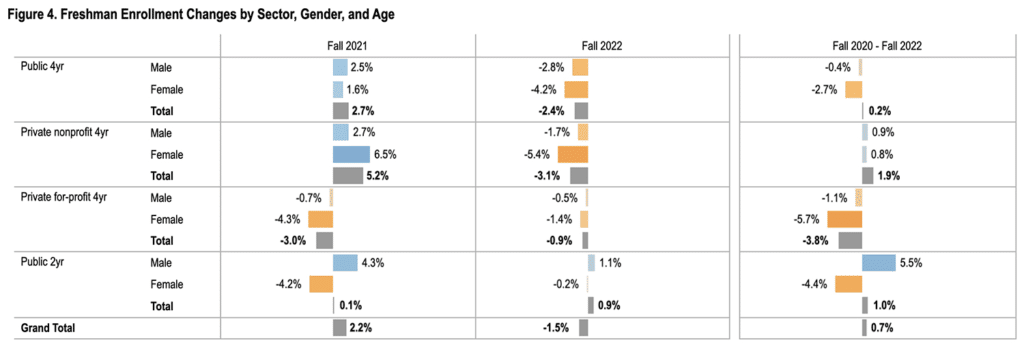Since the fall of 2020, there have been significant drops in female freshmen, raising concerns for women’s long-term economic security.
According to a report from the National Student Clearinghouse Research Center, there is a significant disparity in fall 2022 college freshman enrollment between genders, with females withdrawing at a rate that is more than twice that of males.
The National Student Clearinghouse Research Center’s findings reveal a decline in enrollment for male freshmen at four-year universities and community colleges by 1.3 percent, while the decline for female freshmen was at 3.2 percent.
The most recent report shows that in spring 2022, there were over 462,000 fewer female students (-4.6 percent), doubling the losses from the previous year for a two-year decline in female enrollments of 665,000.
Additionally, the research center found a 1.5 percent decrease in college freshman enrollment between the fall of 2020 and 2022, with 90 percent of students aged between 18 and 20 years old.
The most significant declines among college freshmen in the fall of 2022 were seen among White, Asian, and Black students, with a 7, 3.2, and 2 percentage point decrease, respectively.

“After two straight years of historically large losses, it is particularly troubling that numbers are still falling, especially among freshmen,” said Doug Shapiro, Executive Director of the National Student Clearinghouse Research Center. “Although the decline has slowed and there are some bright spots, a path back to pre-pandemic enrollment levels is growing further out of reach.”
Catherine Brown, senior director of policy and advocacy for the National College Attainment Network, said, “The pandemic disproportionately harmed women, particularly women of color and low-income women, and this is one more example of that impact.”
Brown noted that during the pandemic, women were disproportionately taking on responsibilities such as homeschooling, caring for children, and caring for elderly or sick family members.
Need to rewrite below
According to Stephen Barker, the director of communications at OneGoal, the trend of caretaking has extended to young women taking on an unfair share of caring for their siblings while their parents are working.
“There were a lot of barriers for girls to get through the school work and graduate from high school. “It’s something unique to a lot of girls who would have otherwise been college-bound,” Barker said.
The research center discovered that although college enrollment has decreased by 4.2% among all students since the fall of 2020, the rate of decline has slowed and is now similar to pre-pandemic levels. The group examined data from 42 states and found that 27 states had a decrease in enrollment this fall.
While some states saw an increase in enrollment, the most significant increases were in South Carolina, New Hampshire, and New Mexico. The states that saw the most significant declines were Alaska, Michigan, Kansas, Missouri, and Nevada, all of which saw enrollment declines of between 4.3 and 5.2 percentage points.
In addition, Barker noted that the decline in female freshmen’s college enrollment is a new trend that might take a while to change.
“As the economy recovers and we’re past this need for something immediate for girls to support their families and themselves, then I think we’ll see them pivoting and returning back to school,” Barker said.





